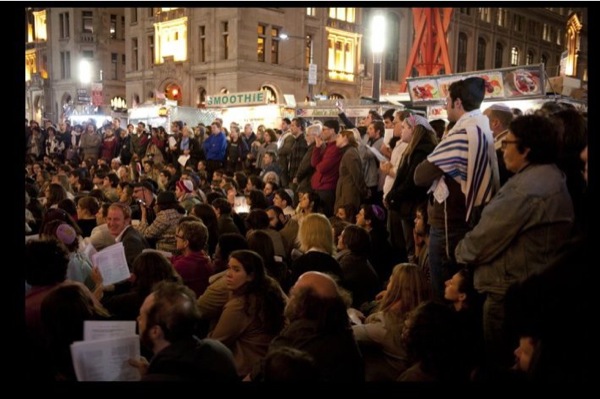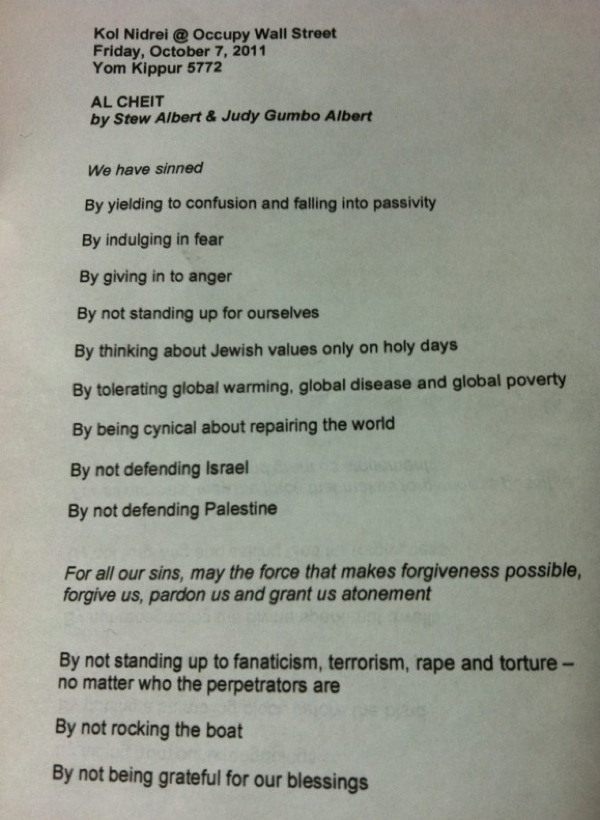When new media activist Daniel Sieradski, a.k.a. the Orthodox Anarchist, a.k.a. @mobius1ski , suggested having an ad hoc Kol Nidre minyan on Wall Street, in solidarity with the Occupied Wall Street movement, he wondered if he would succeed in attracting 20 participants (an egalitarian minyan of 10 men and 10 women).
To his amazement, over 1,000 Jews of all ages and backgrounds, from secular to observant, showed up for an exhilarating experience which, judging from the tweets (hashtag: #OccupyYomKippur), had many people feeling as though they were practically levitating. Several friends told me it was an incredibly moving experience.
@newyorkobserver: Best. Atonement. Ever.
@mikrmoore: Prayed kol nidre with hundreds tonite at #occupywallstreet. Incredibly moving experience. Congrats again to@mobius1ski for pulling it off.
@maxblumenthal Hundreds of Jews declare in unison at #occupaywallstreet “We will hold ourselves accountable for the occupation of Palestine. Aleinu!”
@aimeeweiss #OccupyYomKippur at #occcupywallstreet #ows was simply awe-inspiring. Kol hakavod to @mobius1ski et al. Can’t wait for Sukkot.
@aimeeweiss also tweeted a photo of the supplemental ‘al kheit,’ the traditional confession of sins for which we try to atone by praying and fasting on Yom Kippur. The sins listed on the #occupyyomkippur ‘al kheit’ include, ‘being cynical about repairing the world,’ ‘not defending Israel’ and ‘not defending Palestine.’
@aimeeweiss also uploaded a short video clip of the singing at the Kol Nidre service. Even in these few seconds, one can sense the spiritual and communal warmth of this gathering.
UPDATE: Another video, posted on YouTube, shows spontaneous dancing on the street after the Kol Nidre service ended:
[youtube]http://www.youtube.com/watch?v=2wUyeFKBl4E[/youtube]
UPDATE 2: George ‘Getzel’ Davis posted the sermon he read at #OccupyYomKippur on his Facebook page. Here is the text:
Friends – we are here tonight to celebrate the holiest day of the year, Yom Kippur. Yom Kippur has been misunderstood to be a sad day. But really, an early rabbinic texts calls Yom Kippur one of the two happiest days of the year. What makes this day happy? It is the day of forgiveness. This is what Yom Kippor means “The Day of Forgiveness.”
According to our myth, Yom Kippur is the day that we are forgiven for worshipping the golden calf. What is the golden calf? It is the essence of idol worship. It the fallacy that gold is God. How do we become forgiven for worshiping gold?
I believe that G!d is infinitely forgiving. The harder question is how we forgive ourselves. How can we forgive ourselves for failing to live up to our own ideals? How can we forgive ourselves for failing to recognize others’ humanity? How can we forgive ourselves for remaining silent for so long in the face of injustice?
Forgiveness is important because once we can mourn our mistakes then we are no longer ruled by them. We are free to create things anew.
This is what Kol Nidreh is about. It is releasing ourselves from the oaths that we mistakenly took.
When people think about oaths, they usually think of verbal promises. In Judaism though, most of our oaths are “Chazakas” – or oaths taken through repeated action. By doing things again and again, we make internal promises about how we want to live. Other names for these might be habits, preferences, or addictions. These chazakas rule our lives, making things simpler by allowing us to live on autopilot .
The problem with this is that while chazakas are easy, they are often not skillful. It is easier to not make waves. It is easier to not make eye contact with those suffering. It is easier to trust others to run society. It is easier to sit on our butts.
Tonight, you are offered all the internal freedom that you can imagine. How do you want to live the next moments of your life? Do you want to love more? Do you want to be more joyous? Do you want to speak your truth? What does your truth say?
Yom Kippur is the happiest day of the year because it gives us the radical option of being here now. We don’t work. We don’t eat. We don’t drink. We don’t have sex. We dress in white robes.
We do these things because Yom Kippur is a ritual death. It is the way that we allow our old selves to die.
Tomorrow, when we break our fasts, we step into newness. We step into being the people we want to be and not just the people we have been.
You know friends, it is hard not to worship gold, or power, or any of the other idols that our society shoves down our throats. I believe that this is why the Torah tells us that there is something else created in the image of G!d.
Us.
In the first chapter of Genesis the first human was created in the image of G!d If we need something to serve here on earth, we are given humanity. Service to humankind is sacred and a reflection of service of G!d.
This is the reason why we pray the Aleinu. Aleinu means “On us,” and is our affirmation that it is our job to change the world. Tonight, we will pray the Aleinu in an unconventional way. One at a time, someone will call out a commitment: a new commitment that they want to take on to fix the world. If you also want to take this on, respond by saying “Aleinu.”
Extraordinary.
Could this be a renaissance of a new movement, composed of Jews who are proudly identified with their community and progressive on all issues – including Palestine, the once-great taboo?
Read more about #occupyyomkippur on
The Huffington Post (including a set of beautiful photographs)



